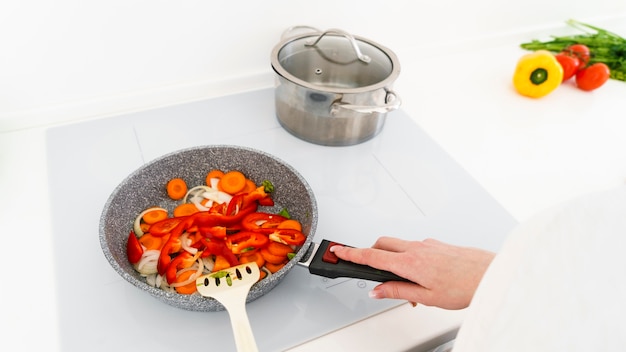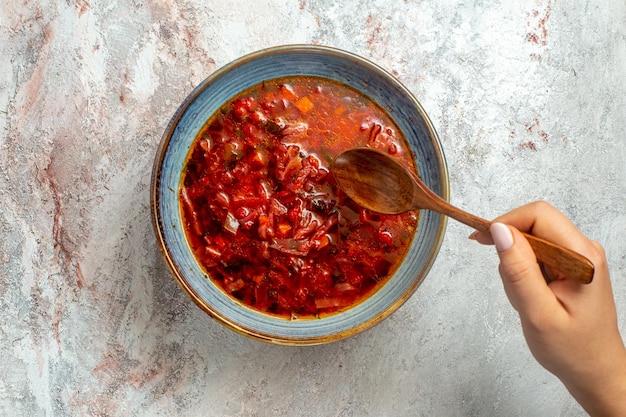You've probably heard the hype surrounding kimchi, the vibrant Korean fermented side dish that's taken the world by storm. You've seen the beautiful red hues, smelled the tantalizing spicy aroma, and heard tales of its incredible health benefits. But you're probably thinking, "Can I really make this at home?" And the answer is a resounding YES!
I've been making kimchi for years, and it's become a bit of a passion project for me. It's not just about the delicious taste, it's about the process – the anticipation, the satisfaction of creating something so unique and flavourful. It's a journey of transformation, both for the ingredients and for yourself.
This guide will walk you through everything you need to know to make kimchi from scratch, from choosing the right ingredients to mastering the fermentation process. So, grab your apron, get your hands dirty, and let's dive into the exciting world of kimchi!
(Part 1) Choosing the Right Ingredients

The Heart of the Matter: Napa Cabbage
You can't talk about kimchi without talking about Napa cabbage, the star of the show. This is the foundation of our delicious journey. Look for firm heads with crisp, bright green leaves and avoid any that look wilted or discoloured. You want a cabbage that's heavy for its size, which means it's packed with moisture, crucial for the fermentation process.
There are different types of Napa cabbage out there, and some are better suited for kimchi than others. I personally prefer the 'Choi' variety, which is a bit thinner and sweeter than other types. It adds a delicate sweetness that balances the fiery spice. However, it comes down to personal preference, so experiment and find your favourite.
Spice is the Spice of Life: Gochugaru (Korean Chilli Powder)
The flavour profile of kimchi is largely determined by gochugaru, the unique Korean chilli powder. This isn't your average chilli powder; it has a rich, slightly sweet flavour and a beautiful reddish hue. The type of gochugaru you use can drastically change the final taste of your kimchi, so it's worth researching to find the perfect one for you.
For a milder flavour, try a gochugaru made from 'Gochujang' chilli peppers, which have a sweeter, less pungent flavour. If you like it hot, opt for a 'Suncho' gochugaru, known for its intense heat. I typically go for a mix of the two, striving for a balance of spice and flavour.
Beyond the Basics: Essential Ingredients
Now, let's explore the other key ingredients that contribute to kimchi's unique flavour profile:
- Garlic: Garlic adds a pungent, earthy flavour that cuts through the spice of the gochugaru and adds a depth of complexity.
- Ginger: Ginger lends a warm, earthy flavour and helps to enhance the fermentation process. It adds a subtle warmth that complements the other ingredients beautifully.
- Green Onions: Green onions contribute a fresh, slightly sharp flavour and provide a delightful visual contrast to the red cabbage. They also add a touch of crunch to the final product.
- Sea Salt: Sea salt is crucial for drawing out the water from the cabbage, a vital step for successful fermentation. The salt helps to create the right environment for the beneficial bacteria to thrive.
- Fish Sauce: Fish sauce adds a powerful umami depth to the flavour, adding another layer of complexity. It's a controversial ingredient, though, as its strong flavour can be off-putting to some. Feel free to omit it if you're not a fan. I personally like to use a small amount for a hint of umami richness.
- Sugar: A small amount of sugar helps to balance the sourness of the kimchi, creating a more rounded, harmonious flavour. It helps to create a delicate sweetness that balances the other flavours.
- Rice Flour: Rice flour is used to create a paste that helps to bind the ingredients, resulting in a smooth, consistent texture. It's a subtle touch, but it really makes a difference in the final product. You can substitute rice flour with cornstarch or potato starch if you prefer.
(Part 2) Preparing the Cabbage

Now that we've got our ingredients, let's begin preparing the cabbage. This step is all about making the cabbage soft and receptive to the other flavours.
Washing and Cutting the Cabbage
Start by washing the cabbage thoroughly, removing any dirt or debris. Then, cut the cabbage in half lengthwise. Now, it's time to cut the cabbage into roughly 2-inch thick slices, keeping the leaves intact as much as possible. This will help to ensure that the kimchi ferments evenly and retains its shape.
Salting the Cabbage: The Transformation Begins
This is where the magic starts to happen. We need to draw out the water from the cabbage to soften it and make it more receptive to the flavours of the kimchi paste. Generously salt both sides of the cabbage slices, using about 1 tablespoon of sea salt per head of cabbage.
The Patient Wait: Letting the Cabbage Rest
Now for the patient part. Let the salted cabbage rest for at least 2 hours, or even overnight, until the leaves have softened and have released a good amount of liquid. The cabbage will begin to transform, becoming pliable and ready to absorb the flavours of the kimchi paste.
(Part 3) Creating the Kimchi Paste

Now comes the exciting part – creating the spicy, flavourful paste that will coat the cabbage. This is where you can unleash your creativity and experiment with different flavours and spice levels.
Mixing the Ingredients: The Foundation of Flavour
In a large bowl, combine the gochugaru, garlic, ginger, green onions, and rice flour. Mix them together well to create a paste, and then add a bit of water at a time until you have a smooth, slightly runny paste. The consistency should be similar to thick yogurt.
Adding the Finishing Touches: Fish Sauce and Sugar
This is where you can add the fish sauce and sugar, if you choose. I personally prefer a small amount of fish sauce, about 1 tablespoon per head of cabbage, for a subtle umami kick. But as mentioned before, this is completely up to your preference. As for sugar, I use about 1 teaspoon per head of cabbage, but feel free to adjust based on your taste. Mix these ingredients thoroughly into the paste to ensure everything is evenly distributed.
(Part 4) Assembling the Kimchi
Now that we have our prepped cabbage and our spicy paste, it's time to bring everything together. This is the moment where you get to see your kimchi come to life.
Preparing the Jar: Creating a Safe Environment
First, sterilise your kimchi jar or container by boiling it in water for a few minutes. This will help to prevent the growth of any unwanted bacteria and ensure that your kimchi ferments safely.
Layering the Cabbage and Paste: The Heart of the Process
Now, carefully take the softened cabbage and layer it in the jar, starting with the base. Don't be afraid to press down on the cabbage to release some of the excess water. Then, generously spread a thick layer of the kimchi paste over the cabbage, ensuring that every leaf is coated. Repeat this layering process until the jar is full, pressing down firmly on the top layer of cabbage to ensure that it's completely submerged in the paste and any excess liquid.
Keeping the Cabbage Submerged: The Importance of Weight
This is a crucial step for a successful fermentation: keeping the cabbage submerged in the paste. You can achieve this using a heavy weight, such as a plate or a jar filled with water. This will prevent the cabbage from being exposed to air and will help to create a more consistent and evenly fermented kimchi.
(Part 5) Fermenting the Kimchi: The Magic Happens
We've reached the most important part of the process – fermentation. This is where the magic happens, and your kimchi truly develops its unique flavour and texture.
Room Temperature Fermentation: The First Stage
For the first stage of fermentation, keep the kimchi at room temperature, ideally between 68-72°F (20-22°C). This is the optimal temperature for the beneficial bacteria to thrive and start the fermentation process. You'll notice a few changes over the next few days: The kimchi will start to produce gas and will develop a sour aroma. The cabbage will also begin to soften and become more pliable.
Refrigeration: The Second Stage
Once the kimchi has fermented for about 3-5 days, transfer it to the refrigerator. This will slow down the fermentation process and allow the kimchi to develop a more complex flavour. You can keep the kimchi in the refrigerator for several months, and it will continue to ferment slowly over time.
(Part 6) Enjoying Your Homemade Kimchi: The Final Reward
Congratulations! You've now made your own kimchi. The next part is the most exciting – tasting your creation!
The Wait Is Over: Enjoying Your Kimchi
You can start to enjoy your kimchi after it's fermented for 3-5 days, but I find it tastes best after a week or two. It's worth the wait, as the flavours will have had time to meld and develop a harmonious balance.
A Versatile Side Dish: Kimchi's Many Applications
Kimchi is incredibly versatile and can be enjoyed in a variety of ways. Traditionally, it's served as a side dish with Korean meals, but it can also be used as a topping for rice, noodles, or even tacos. You can even add it to soups and stews for an extra kick of flavour.
(Part 7) Tips and Troubleshooting
Making kimchi is an art, but with a few tips and tricks, you'll be well on your way to creating delicious kimchi.
Tips for Success
Here are a few tips to help you make the most delicious kimchi:
- Use fresh, high-quality ingredients. This will make a big difference in the taste and texture of your kimchi.
- Don't be afraid to experiment. Kimchi is all about personal preference, so feel free to adjust the amount of spice, sugar, or fish sauce to your liking.
- Keep an eye on the fermentation process. Check on your kimchi regularly to ensure that it's fermenting properly. If you notice any unusual changes in the smell or taste, it's best to discard the kimchi.
Troubleshooting Common Issues
Here are some common issues you may encounter when making kimchi:
- The cabbage isn't soft enough. If the cabbage isn't soft enough after salting, you can continue to let it rest for a longer period. If it's still not soft enough, you can gently massage the cabbage to help release more water.
- The kimchi is too salty. If your kimchi is too salty, you can rinse it with cold water to reduce the saltiness. You can also add more water to the paste to dilute the salt.
- The kimchi is too spicy. If your kimchi is too spicy, you can add more sugar to balance out the heat.
- The kimchi is moldy. If your kimchi develops mold, it's best to discard it as mold can be harmful to your health.
(Part 8) FAQs
Here are some frequently asked questions about making kimchi:
Q1: What if I don't have fish sauce?
A1: You can omit the fish sauce completely or use an alternative, such as soy sauce, anchovy sauce, or even just a bit more salt. These will all add a similar umami flavour to your kimchi.
Q2: How long will my kimchi last?
A2: Properly made kimchi will last for several months in the refrigerator. However, it will continue to ferment slowly, so the flavour will change over time. You'll notice it becomes more sour as it ferments.
Q3: Can I make kimchi with other vegetables?
A3: Absolutely! Kimchi can be made with a variety of vegetables, including radishes, cucumbers, and even fruit. There are endless possibilities!
Q4: What if my kimchi doesn't ferment?
A4: If your kimchi doesn't ferment, it could be because the temperature wasn't warm enough, or you didn't salt the cabbage enough. You can try adding a bit of starter culture, which is a mixture of beneficial bacteria that can help to kickstart the fermentation process.
Q5: Is kimchi really good for you?
A5: Kimchi is packed with probiotics, which are good bacteria that are beneficial for your gut health. It's also a good source of vitamins, minerals, and antioxidants. So, yes, kimchi is definitely good for you!
Making kimchi at home is a rewarding experience. It's not just about the delicious taste, it's about the process, the anticipation, and the satisfaction of creating something unique and flavourful. So go on, give it a try. You might just be surprised at how easy and enjoyable it can be!
Everyone is watching

How to Cook Frozen Lobster Tails Perfectly: A Step-by-Step Guide
RecipesLobster. Just the word conjures up images of lavish meals, special occasions, and a taste of luxury. But let's...

Pigs in a Blanket Cooking Time: How Long to Bake for Perfect Results
RecipesAh, pigs in a blanket. Just the name conjures up images of those delightful little parcels of crispy pastry en...

Pork Fillet Cooking Time: How Long to Cook It Perfectly
RecipesPork fillet, or tenderloin as it's sometimes called, is a real favourite in our house. It's so versatile, and...

The Ultimate Guide to Cooking Delicious Frankfurters
RecipesLet's face it, we all love a good frankfurter. It's a classic, simple, and always satisfying. But let's be rea...

The Ultimate Guide to Tender, Juicy Pulled Pork
RecipesRight, let's talk pulled pork. It's one of those dishes that just screams "comfort food," doesn't it? I mean...
